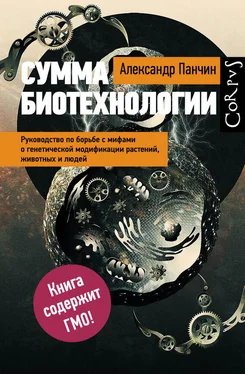234. Aris A., Leblanc S.: Maternal and fetal exposure to pesticides associated to genetically modified foods in Eastern Townships of Quebec, Canada. Reprod Toxicol 2011, 31(4):528–33.
235. Paul V. et al.: Development and validation of a sensitive enzyme immunoassay for surveillance of Cry1Ab toxin in bovine blood plasma of cows fed Bt-maize (MON810). Anal Chim Acta 2008, 607(1):106–13.
236. Kwit C. et al.: Transgene introgression in crop relatives: molecular evidence and mitigation strategies. Trends Biotechnol 2011, 29(6):284–93.
237. http://www.gmofreeusa.org/enigma-portfolio/gmo-science-2/
238. Srivastava V. et al.: Single-copy transgenic wheat generated through the resolution of complex integration patterns. Proc Natl Acad Sci USA 1999, 96(20):11117–21.
239. Bakke-McKellep A. M. et al.: Histological, digestive, metabolic, hormonal and some immune factor responses in Atlantic salmon, Salmo salar L., fed genetically modified soybeans. J Fish Dis 2007, 30(2):65–79.
240. http://www.trinitas.ru/rus/doc/0016/001c/00161613.htm
241. https://isaaa.org/gmapprovaldatabase/countrylist/default.asp
242. Key S. et al.: Genetically modified plants and human health. J R Soc Med 2008, 101(6):290–8.
243. Cascini F.: Investigations into the hypothesis of transgenic cannabis. J Forensic Sci 2012, 57(3):718–21.
244. Abecasis G.R. et al.: A map of human genome variation from population-scale sequencing. Nature 2010, 467(7319): 1061–73.
245. Weigel D., Mott R.: The 1001 genomes project for Arabidopsis thaliana. Genome Biol 2009, 10(5):107.
246. The 3,000 rice genomes project. Gigascience 2014, 3:7.
247. Holst-Jensen A. et al.: PCR technology for screening and quantification of genetically modified organisms (GMOs). Anal Bioanal Chem 2003, 375(8):985–93.
248. Mullis K. et al.: Specific enzymatic amplification of DNA in vitro: the polymerase chain reaction. Cold Spring Harb Symp Quant Biol 1986, 51 Pt 1:263–73.
249. Clelland C.T. et al.: Hiding messages in DNA microdots. Nature 1999, 399(6736):533–4.
250. Munns R. et al.: Wheat grain yield on saline soils is improved by an ancestral Na(+) transporter gene. Nat Biotechnol 2012, 30(4):360–4.
251. Chen D. et al.: HIF-1 modulates dietary restriction-mediated lifespan extension via IRE-1 in Caenorhabditis elegans. PLoS Genet 2009, 5(5):e1000486.
252. Jouanin L. et al.: Lignification in transgenic poplars with extremely reduced caffeic acid O-methyltransferase activity. Plant Physiol 2000, 123(4):1363–74.
253. Sheehy R.E. et al.: Reduction of polygalacturonase activity in tomato fruit by antisense RNA. Proc Natl Acad Sci USA 1988, 85(23):8805–9.
254. Tuteja J.H. et al.: Tissue-specific gene silencing mediated by a naturally occurring chalcone synthase gene cluster in Glycine max. Plant Cell 2004, 16(4):819–35.
255. Todd J.J., Vodkin L.O.: Duplications That Suppress and Deletions That Restore Expression from a Chalcone Synthase Multigene Family. Plant Cell 1996, 8(4):687–99.
256. Parrott W. et al.: Application of food and feed safety assessment principles to evaluate transgenic approaches to gene modulation in crops. Food Chem Toxicol 2010, 48(7):1773–90.
257. Denis M. et al.: Expression of Engineered Nuclear Male Sterility in Brassica napus (Genetics, Morphology, Cytology, and Sensitivity to Temperature). Plant Physiol 1993, 101(4):1295–304.
258. Granzier H.L., Labeit S.: The giant muscle protein titin is an adjustable molecular spring. Exerc Sport Sci Rev 2006, 34(2):50–3.
259. Bang M.L. et al.: The complete gene sequence of titin, expression of an unusual approximately 700-kDa titin isoform, and its interaction with obscurin identify a novel Z-line to I-band linking system. Circ Res 2001, 89(11):1065–72.
260. Neves G. et al.: Stochastic yet biased expression of multiple Dscam splice variants by individual cells. Nat Genet 2004, 36(3):240–6.
261. Hattori D. et al.: Dscam-mediated cell recognition regulates neural circuit formation. Annu Rev Cell Dev Biol 2008, 24:597–620.
262. Noren C.J. et al.: Dissecting the Chemistry of Protein Splicing and Its Applications. Angew Chem Int Ed Engl 2000, 39(3):450–66.
263. Holley R.W. et al.: Nucleotide Sequences in the Yeast Alanine Transfer Ribonucleic Acid. J Biol Chem 1965, 240:2122–8.
264. Min Jou W. et al.: Nucleotide sequence of the gene coding for the bacteriophage MS2 coat protein. Nature 1972, 237(5350):82–8.
265. Maxam A.M., Gilbert W.: A new method for sequencing DNA. Proc Natl Acad Sci USA 1977, 74(2):560–4.
266. Sanger F. et al.: DNA sequencing with chain-terminating inhibitors. Proc Natl Acad Sci USA 1977, 74(12):5463–7.
267. Smith L.M. et al.: Fluorescence detection in automated DNA sequence analysis. Nature 1986, 321(6071):674–9.
268. Fleischmann R.D. et al.: Whole-genome random sequencing and assembly of Haemophilus influenzae Rd. Science 1995, 269(5223):496–512.
269. Genome sequence of the nematode C. elegans: a platform for investigating biology. Science 1998, 282(5396):2012–8.
270. Analysis of the genome sequence of the flowering plant Arabidopsis thaliana. Nature 2000, 408(6814):796–815.
271. Staden R.: A strategy of DNA sequencing employing computer programs. Nucleic Acids Res 1979, 6(7):2601–10.
272. Adams M.D. et al.: The genome sequence of Drosophila melanogaster. Science 2000, 287(5461):2185–95.
273. Venter J.C. et al.: The sequence of the human genome. Science 2001, 291(5507):1304–51.
274. Lander E.S. et al.: Initial sequencing and analysis of the human genome. Nature 2001, 409(6822):860–921.
275. Initial sequence of the chimpanzee genome and comparison with the human genome. Nature 2005, 437(7055):69–87.
276. Yunis J.J., Prakash O.: The origin of man: a chromosomal pictorial legacy. Science 1982, 215(4539):1525–30.
277. Fan Y. et al.: Genomic structure and evolution of the ancestral chromosome fusion site in 2q13-2q14.1 and paralogous regions on other human chromosomes. Genome Res 2002, 12(11):1651–62.
278. Eid J. et al.: Real-time DNA sequencing from single polymerase molecules. Science 2009, 323(5910):133–8.
279. Mikheyev A.S., Tin M.M.: A first look at the Oxford Nanopore MinION sequencer. Mol Ecol Resour 2014, 14(6):1097–102.
280. Chan I.S., Ginsburg G.S.: Personalized medicine: progress and promise. Annu Rev Genomics Hum Genet 2011, 12:217–44.
281. El-Sohemy A. et al.: Coffee, CYP1A2 genotype and risk of myocardial infarction. Genes Nutr 2007, 2(1):155–6.
282. Muramatsu T. et al.: Alcohol and aldehyde dehydrogenase geno types and drinking behavior of Chinese living in Shanghai. Hum Genet 1995, 96(2):151–4.
283. Bierut L.J. et al.: ADH1B is associated with alcohol dependence and alcohol consumption in populations of European and African ancestry. Mol Psychiatry 2012, 17(4):445–50.
284. Venter J.C. et al.: Environmental genome shotgun sequencing of the Sargasso Sea. Science 2004, 304(5667):66–74.
285. Turnbaugh P.J. et al.: The human microbiome project. Nature 2007, 449(7164):804–10.
286. Arumugam M. et al.: Enterotypes of the human gut microbiome. Nature 2011, 473(7346):174–80.
287. Lamendella R. et al.: Comparative fecal metagenomics unveils unique functional capacity of the swine gut. BMC Microbiol 2011, 11:103.
288. Tazume S. et al.: Effects of germfree status and food restriction on longevity and growth of mice. Jikken Dobutsu 1991, 40(4):517–22.
289. Oresic M. et al.: Gut microbiota affects lens and retinal lipid composition. Exp Eye Res 2009, 89(5):604–7.
290. Ridaura V.K. et al.: Gut microbiota from twins discordant for obesity modulate metabolism in mice. Science 2013, 341(6150):1241214.
291. Vasquez A. et al.: Vaginal lactobacillus flora of healthy Swedish women. J Clin Microbiol 2002, 40(8):2746–9.
Читать дальше
Конец ознакомительного отрывка
Купить книгу




![Александр Панчин - Гарвардский Некромант [litres]](/books/390749/aleksandr-panchin-garvardskij-nekromant-litres-thumb.webp)


![Александр Панчин - Апофения [litres]](/books/435337/aleksandr-panchin-apofeniya-litres-thumb.webp)




